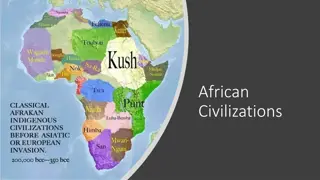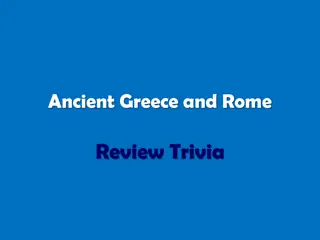Fashion History: From Ancient Civilizations to Modern Times
Explore the evolution of fashion from ancient civilizations like Egyptians, Greeks, and Romans to the high-class society influence in the 15th and 16th centuries. Discover iconic garments like the Egyptian loincloth, medieval Bliaud, and Farthingale of the 1400s. Witness the shift in fashion styles influenced by religious values in the 1600s French Courtiers era.
Download Presentation

Please find below an Image/Link to download the presentation.
The content on the website is provided AS IS for your information and personal use only. It may not be sold, licensed, or shared on other websites without obtaining consent from the author.If you encounter any issues during the download, it is possible that the publisher has removed the file from their server.
You are allowed to download the files provided on this website for personal or commercial use, subject to the condition that they are used lawfully. All files are the property of their respective owners.
The content on the website is provided AS IS for your information and personal use only. It may not be sold, licensed, or shared on other websites without obtaining consent from the author.
E N D
Presentation Transcript
HEC:703 Lecture 1 Fashion History B .C . to P resent T imes
B.C. Fashions of this period come from several groups in existence at this time: Egyptians, Cretes, Greeks, Romans, and Byzantine. Most is known about Egyptian fashion due to their burial procedures. Linen was used exclusively as a textile with the Egyptians because it was all were able to grow in their area.
Egyptian Fashions The Shenti was the loincloth worn by Egyptian men. The Kalasiris was a linen gown worn by Egyptian women.
1200-1300s, 13th & 14th Century The Bliaud was a dress worn by woman or men in this time period.
1200-1300s The Hennin, was worn in the 14th and 15th century, was a cone- like hat resembling the spires of the cathedral spire. The Tunic was often one of the stylistic features of the classic businessman.
1400-1500s the 15th & 16th Century Fashion in this era was greatly influenced by the high class society and the European Kings and Queens. The Surcoat was a popular fashion accessory for the men of this era. Peasants had a lot of different clothing styles because each particular style identified the woman with her hometown.
1400-1500s Women of this time used Pregnancy Pillows when the maternal look was fashionable. Men of this time wore a Codpiece, a decorative triangular piece of fabric attached at the groin.
1400s-1500s The Farthingale was a stiff metal cone-shaped article worn under skirts, while the Ruff was a large stiff collar worn at this time. Farthingale Ruff
1600s The French Courtiers influence for this time was a fashion which said I don t have to work for a living. The Puritan costumes were very simple. When religious values are ascendant, dress becomes austere ( influence of religion is strong on costumes).
1600s Fashions In Denmark the Short Jacket and Breeches were the style of the day.
1700s The 1700 s started with the drastic extension of both the hips and the hair for women. Women were beginning to make contributions to society by becoming writers, business women, artists and doctors. The drastic visual display of their dress was a spectacle which far outweighed the proportions of a man.
1700s This shows the hoop and mask used under a ladies dress to extend the hips drastically.
1770s Hair was piled high on the head in the Pompadour style and atop the mountain of hair (which usually included pieces of someone else s hair called a Rat) sat large hats topped with feathers, bows and ribbons.
1700s The Justaucorps for men was the forerunner of today s suitcoat. The Spencer was a short jacket without tails.
1700s Near the end of the 1700 s women began to wear dresses that followed the simple lines of the Greek silhouette. The hair softened at this time as well. Women left behind the corset for a brief time. 1790, Napoleon s sisters
Movies representing the 18th Century Amadeus (1750)* (Mozart 1756 1791) Emma (1816)* Catherine the Great The Aristocrats
1800s Fashion at this time went through some very distinct changes. The 19th century starts with the Greek influence, then woman gradually add to the dress until the Greek is not noticeable. The corset returns! The high society had rich fashions, while the common people dressed simply. It was an era of romance and manners
1800s The well-dressed man of the nineteenth centruy England was called a Dandy. The well-dressed woman wore a large bell-shaped skirt supported by crinoline. The Worth creation brought the fullness of women s skirts around to the back. 1820 1850 1880
1890s Exaggerated Hourglass 1895, Paris 1895
1890s Gibson Girl Artist s sketches of young women by Charles Dana Gibson, known as the Gibson Girls, were published in newspapers and set the standard for the all- American girl.
1890s The exaggerated Hourglass was the silhouette style of this decade. Shoulders were wide, waists were cinched in unmercifully by corsets and the hip was incredibly increased by the bustle.
Tutorial-Current trend Identify and discuss the factors that have influenced the fashion industry. Explain the relationship between fashion and textile technology. Demonstrate your understanding of current trend . Do women today dress to reveal their personality or do they follow the designers? Whose choice?























